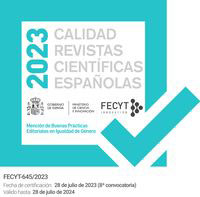From Bama’s Karukku ([1992] 2014) to Yashica Dutt’s Coming Out as Dalit: A Memoir (2019): The Changing Nature of Dalit Feminist Consciousness
DOI:
https://doi.org/10.14198/raei.2023.38.01Keywords:
Dalit Studies, Caste System, Gendered Casteism, Feminist Studies, Dalit Female ConsciousnessAbstract
Dalit literature articulates the oppression and exploitation faced by Dalits in a caste-ridden society as it records their social and cultural lives before and after India’s independence. This cultural revolt that burgeoned in the 1970s has largely been Dalit male-centric in its orientation, adopting paternalistic and patronising tones towards Dalit women. As a consequence, Dalit women remained firmly encapsulated in the patriarchal roles of the silent, agenciless and ‘victimised sexual being,’ perpetuating thus gendered stereotypes. These accounts failed to properly address Dalit women’s predicament and the interlocking oppression of caste and gender, which compelled them to create a distinct space for themselves. Dalit women have traversed a long path over the last four decades. During this time, their consciousness has evolved in many ways as reflected in Dalit writing. Life narratives, such as Bama’s Karukku and Yashica Dutt’s Coming Out as Dalit: A Memoir, function as the locus of enunciation where agency and self-identity are attended and asserted by Dalit women, through different approaches. As the social location determines the perception of reality, this paper attempts a look at how these two texts tackle and bring to the centre the gendered nature of caste and the power relations that still affect Dalit women, from a heterogeneous standpoint. It further analyses how through form, language and subject matter, Dalit women attempt to defy generic conventions, depart from imposed identities, and build up resistance against this enduring double oppression and the forces that insist on homogenising Dalit body politics.Funding
Spanish Ministry of Economy, Industry and Competitiveness (MINECO), the European Regional Development Fund (DGI/ERDF) (code FFI2017-84258-P), the Government of Aragón and the FSE 2020-2022 programme (code H03_20R)References
AMIN, Shahid and Dipesh Chakravarthy. 1996. Subaltern Studies IX: Writings on South Asian History and Society. New Delhi: Oxford UP.
ARNOLD, David and Stuart Blackburn. 2004. Telling Lives in India: Biography, Autobiography and Life History. Bloomington: Indiana UP. https://doi.org/10.35632/ajis.v23i4.1589
BAMA. 1999. “Dalit Literature.” Indian Literature 197 (September-October): 97-98.
BAMA. 2001. “Recognition for the Language of My People Is the Biggest Award I Can Win.” Outlook of India (April). https://www.outlookindia.com/website/story/recognition-for-the-language-of-my-people-is-the-biggest-award-i-can-win/211431 (Accessed online on February 10, 2022).
BAMA. [1992] 2014. Karukku. New Delhi: Oxford UP.
BRAUDY, Leo and Marshall Cohen. 1999. Film Theory and Criticism: Introductory Readings. New York: Oxford UP.
BUTLER, Judith. 1993. Bodies That Matter: On the Discursive Limits of Sex. New York: Routledge.
BUTLER, Judith. 1999. Gender Trouble: Feminism and the Subversion of Identity. New York: Routledge.
CHAKRAVARTI, Uma. (2003) 2013. Gendering Caste: Through a Feminist Lens. Calcutta: Stree.
DALTON, Fiona. 2008. “Transforming Dalit identity: Ancient Drum Beat, New Song.” Master’s thesis, The Victoria University of Wellington, New Zealand. http://researcharchive.vuw.ac.nz/handle/10063/329 (Accessed online on February 13, 2022).
DASH, Santosh. 2020. “Of Subjecthood and Form: On Reading Two Dalit Short Stories from Gujarat, India.” In Misrahi-Barak, Satyanarayana and Thiara 2020, 91-104.
DHILLON, Amrit. 2020. “Coming Out as Dalit: How One Indian Author Finally Embraced Her Identity.” The Guardian. https://www.theguardian.com/global-development/2020/feb/19/coming-out-as-dalit-how-one-indian-author-finally-embraced-her-identity (Accessed online on May 2, 2022).
DIETRICH, Gabriele. 2003. “Dalit Movement and Women’s Movement.” In Rao 2003, 57-79.
DUTT, Yashica. 2019. Coming Out as Dalit: A Memoir. New Delhi: Aleph Book Company.
ERIKSON, Erik. 1968. Identity, Youth and Crisis. New York: W. W. Norton Company.
GAJARAWALA, Toral. 2013. Untouchable Fictions: Literary Realism and the Crisis of Caste. New York: Fordham UP. https://doi.org/10.5422/fordham/9780823245246.001.0001
GURU, Gopal. 2008. “Afterword.” In Kamble 2008, 158-170.
GUPTA, Charu. 2011. “Writing Sex and Sexuality: Archives of Colonial North India.” Journal of Women’s History 23 (Winter): 12-35. https://doi.org/10.1353/jowh.2011.0050
KAMBLE, Baby. 2008. The Prisons We Broke. New Delhi: Orient Blackswan.
KRISHNAN, Mini. 2014. “Editor’s Note to the First Edition.” In Bama 2014, xxv.
KUMAR, Raj. 2010. Dalit Personal Narratives: Reading Caste, Nation and Identity. New Delhi: Orient Blackswan.
KUMAR, Udaya. 2013. “Consciousness, Agency and Humiliation: Reflections on Dalit Lifewriting and Subalternity.” In Zene 2013, 158-170.
MALIK, Bela. 2005. “Untouchability and Dalit Women’s Oppression.” In Rao 2005, 102-107.
MISRAHI-BARAK, Judith, K. Satyanarayana and Nicole Thiara. 2020. Dalit Text: Aesthetics and Politics Re-Imagined. London and New York: Routledge. https://doi.org/10.4324/9780367149031
MULVEY, Laura. 1999. “Visual Pleasure and Narrative Cinema.” In Braudy and Cohen 1999, 833-844.
MENON, Ritu. “The Dissenting Feminist Voice in a Globalised Marketplace.” Lecture given at Emory University, Atlanta, November 2004.
NAIK, Purnachandra. 2016. “Baby Kamble to Bama: Dalit Women Write Differently.” Economic and Political Weekly 51: 16-19. https://www.jstor.org/stable/44165812 (Accessed online on May 2, 2022).
PAWAR, Urmila. 2008. The Weave of My Life: A Dalit Woman’s Memoirs. Calcutta: Stree. https://doi.org/10.7312/pawa14900
RAO, Anupama. 2003. Gender and Caste. Delhi: Kali for Women.
REGE, Sharmila. 1998. “Dalit Women Talk Differently: A Critique of ‘Difference’ and towards a Dalit Feminist Standpoint Position.” Economic and Political Weekly 34 (October 31): 39-46. http://www.jstor.org/stable/4407323
SARANGI, Jaydeep. 2018. “Dalit Feminist Activist Writes Back: Bama Faustina in Conversation with Jaydeep Sarangi.” Writers in Conversation 5 (February 1-8). https://doi.org/10.22356/wic.v5i1.27
THARU, Susie and Tejaswini Niranjana. 1996. “Problems for a Contemporary Theory of Gender.” In Amin and Chakravarthy 1996, 232-260.
WATSON, Julia and Sidonie Smith. 2010. Reading Autobiography: A Guide for Interpreting Life Narratives. Minneapolis: University of Minnesota Press.
ZENE, Cosimo. 2013. The Political Philosophies of Antonio Gramsci and B. R. Ambedkar: Itineraries of Dalits and Subalterns. New York: Routledge. https://doi.org/10.4324/9780203762035
ZENE, Cosimo. 2020. “Self-consciousness of the Dalits as ‘Subalterns’: Reflections on Gramsci in South Asia.” Reflections on Gramsci in South Asia: Rethinking Marxism: A Journal of Economics, Culture & Society 23: 83-99. https://doi.org/10.1080/08935696.2011.536342
Downloads
Statistics
Published
How to Cite
Issue
Section
License
Copyright (c) 2023 Bianca Cherechés

This work is licensed under a Creative Commons Attribution 4.0 International License.





